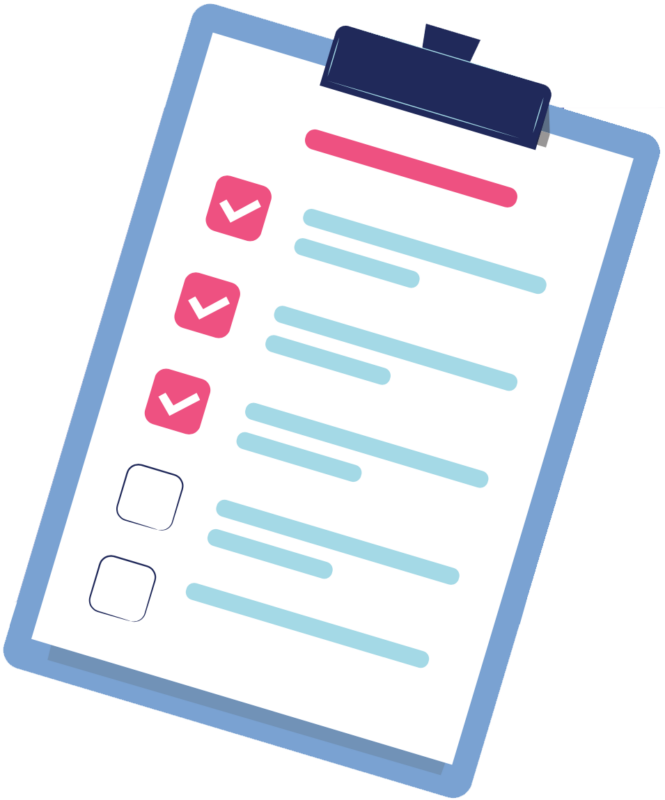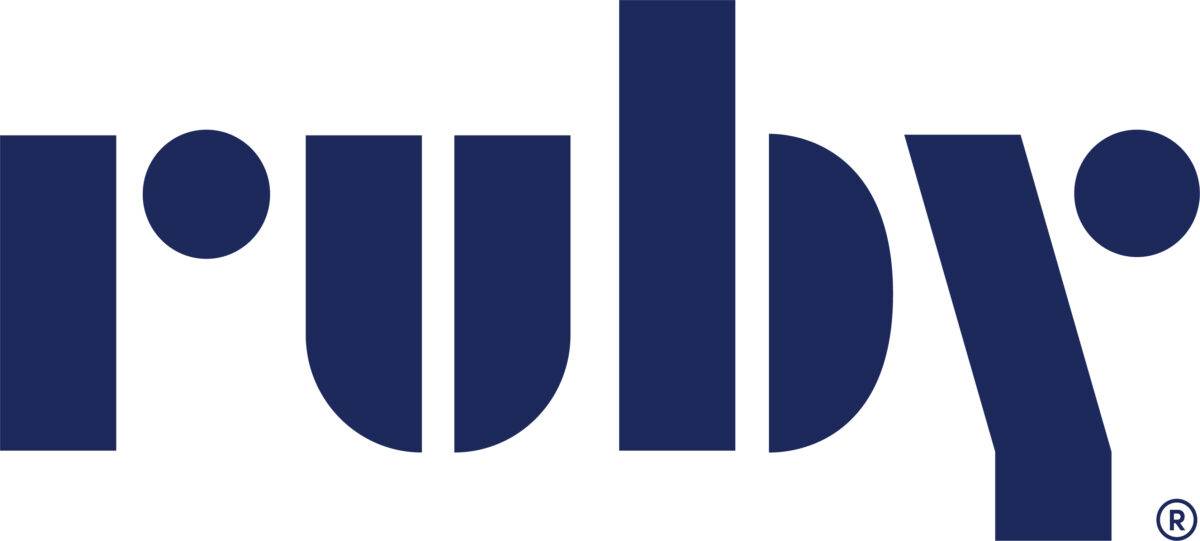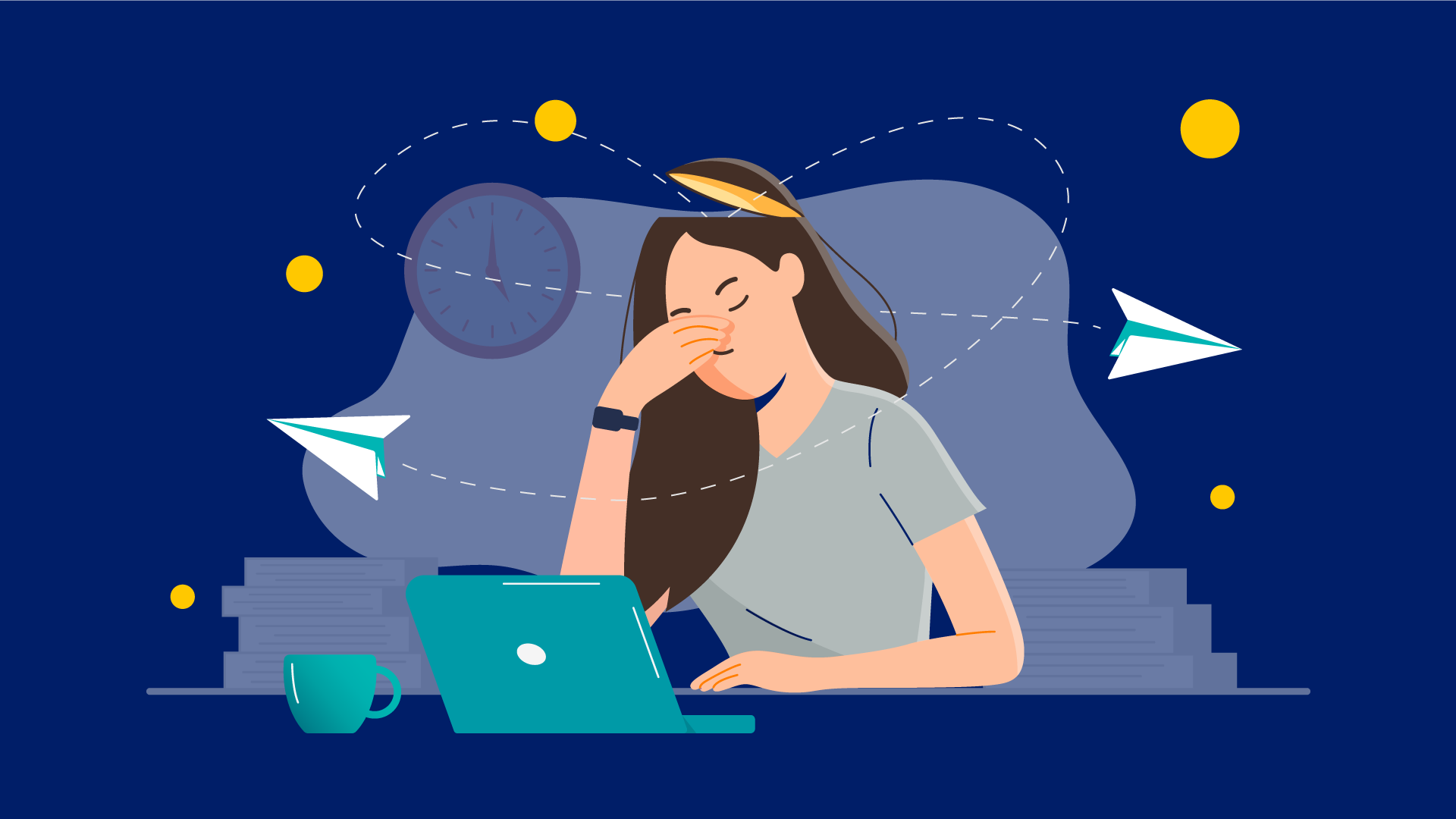
Did you know that approximately 15 million Americans live with ADHD?
Did you also know that of those 15 million people, only one in four is receiving treatment for it? Isn’t that alarming?! We think so.
While we here at Ruby don’t claim to be medical or mental health experts, we are a team of humans who deal with human obstacles, just like you. Some of us here have ADHD, AKA Attention-Deficit/Hyperactivity Disorder and are doing our very best to work with it rather than against it—especially in the corporate world. Your writer is one of those people.
Are you a business owner with ADHD? Or suspect you might have ADHD and would like a few tips to add to your arsenal? Again, not an expert, but I have scoured the internet and reached out to colleagues, friends, and family, who have ADHD to talk about how it affects their work. After analyzing my notes, I’ve compiled a list I’d like to share with you, here are 10 tips for a business owner with ADHD.
Table of contents
Tip 1: If you’re a business owner, you might already be on the right track.

Depending on how you view it, having ADHD can be a helpful thing, a challenging thing, or a combination of both. It really does depend on your own perception.
While there are plenty of ADHD traits that can make owning a business challenging, there are also plenty of positive traits. Consider innovativeness, proactiveness, or risk taking, for example. These are generally considered positive traits for anyone operating a business.
While researching if there were links between ADHD and entrepreneurialism, I found that leaders with ADHD can outperform competitors who don’t have symptoms that come from ADHD.
Discovering that information was initially surprising, but after thinking more about it, it really does make a lot of sense! People with ADHD can be incredibly creative with the way they view and absorb information. The hyperactivity in their minds tends to let them think about the next thing, and then the next thing, while a neurotypical person may be resting. It can feel like a blessing and a curse—I know.
Tip 2: It may seem obvious, but write things down.
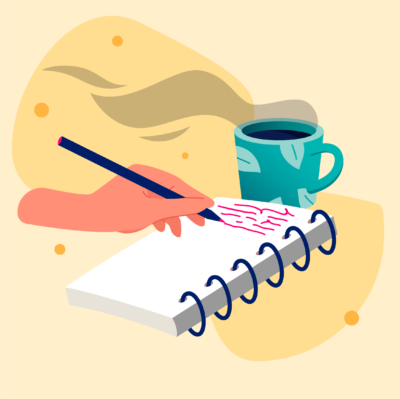
You may already know this, but there is a scientific link between writing things down and remembering them easier. While this is more for physical writing (pen and paper) versus typing, for the most part the principle still stands.
A way this can be beneficial for people with ADHD specifically though is during meetings. I’ve personally found that writing down what has been covered not only helps you remember what was discussed, but you can turn those notes you’ve written into action items, tasks, follow-up questions, or something to investigate.
Another way to make notes work for you is that you can jot down the things you may want to say. Some people with ADHD have symptoms like poor working memory, poor impulse control, and sometimes an inability to concentrate on what they need to. This can lead a lot of people with ADHD to accidentally interrupt or cut somebody off, for fear they will lose their thoughts. If this sounds like you, try writing down the thoughts you want to share. That way, when the moment strikes—like, at the end of the meeting, or before the topic changes—you’ll remember what you wanted to bring up earlier.
The last and (perhaps most important) note here is that by getting your thoughts or questions written down, you know they’re there—not going anywhere—which can help you focus more on the moment itself.
Tip 3: Use a to-do list or a planner.
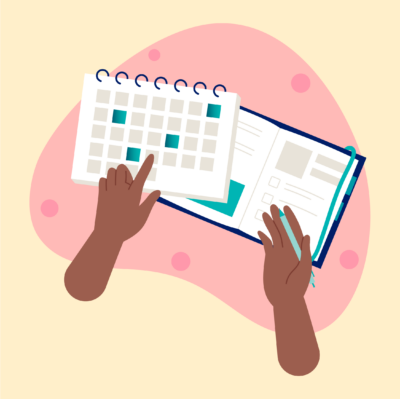
If you’re familiar with ADHD and how it affects the brain, you may also already know about the links between ADHD and lack of dopamine. This just means that if you have ADHD and complete a task, you may not feel that little rush of relief that most neurotypical folks do—that’s the dopamine! Without it, it can make tasks feel a bit meaningless and leaving you thinking, “well, what’s the point?” This can obviously hinder motivation sometimes.
While it’s not the be-all and end-all, of ways to get dopamine during the workday, I’ve found that having a to-do list or planner really does make a difference. There is already some loose research about how someone can get a small dopamine rush from checking things off a to-do list or planner, whatever your style is!
In my planner, I write it all down. While I use it mostly for work, I also put tasks in there as simple as “do the dishes.” By writing that down, I have set a goal for the day, I am reminded to do it every time I look at my planner, then I do get a small moment of gratification when I get to physically check it off.
Pro tip: If you aren’t able to get that task done today, it’s okay! Just leave it unchecked and get to it when you can next, depending on the deadlines of course. My planner has tons of arrows moving a task I wanted to do on Tuesday to Thursday, for example.
Another tip for a to-do list or planner is to color code based on importance. You can do a simple green, yellow/orange, and red system, where warmer colors indicate higher priorities—or you can decide another combination based on which colors you want to look at every day! My planner is a colorful, chaotic, yet organized mess that only I would be able to interpret, and I wouldn’t have it any other way. It works for me, and maybe it could work for you too.
The last, and probably most obvious benefit of implementing a to-do list or planner is that it helps with organization and planning. Writing down something as soon as you know it needs to be done will not only make you more likely to do it, but you can also remove it from your mental load. This way you can remember to do all those “I know I need to, but I always forget until it’s in my face again” tasks—like forgetting to replace the toilet paper when you were last in there and saw it was low.
Tip 4: Break down large tasks into bite-sized pieces.
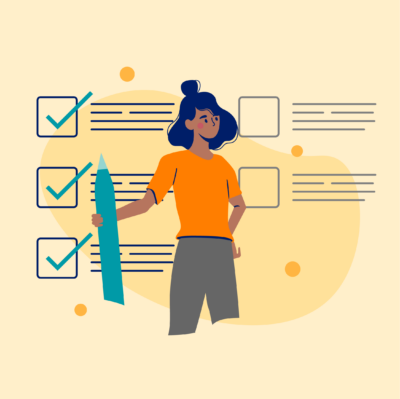
Now this is where we begin talking about executive dysfunction. While I of course can’t speak for everyone who has ADHD, executive dysfunction is one of those things that I’ve found affect nearly everyone. That feeling of staring at your computer or stack of work and just quite literally unable to begin it is unfortunately common. The same thing can be experienced sitting in your chair, on your couch, or even in your car. You’re just kind of stuck there with racing thoughts. You know what you need to do, but you just can’t do it.
Reminder from a fellow person with ADHD: you are not lazy. Just writing this blog took me weeks. I knew what I wanted to talk about, but getting started was the hardest part.
I’m no expert in staving off executive dysfunction—it’s going to be something that will come up on both me and you often. But one tip I can give that may help is to break large tasks down into bite-sized pieces. Staring at a big project with multiple parts is the perfect storm for executive dysfunction to begin creeping in.
Before the overwhelm has a chance to get you, look at your task as a whole and begin to visualize the necessary steps in order to achieve your end goal. This article from Indeed offers five steps to do just that:
- Identify the ultimate goal
- Outline how to accomplish the ultimate goal
- Break down the work into smaller tasks
- Assign timelines and teams for each task
- Measure your progress
I also want to add that it’s okay to jump around on your tasks. Sometimes it’s easier to start with something simple and see where it takes you. This can begin a snowball effect of sorts, and you can get a good flow going and complete way more than you expected. That’s always a best-case scenario!

Tip 5: Hire an answering service.
Some folks with ADHD can feel an almost indescribable rage if they are interrupted when they are, “in the zone” or really focused on a task. If that’s something that you can relate to, boy do I have a solution for you!
By adding an answering service like Ruby to your business, it likely takes the most interrupting part of your day—phone calls—away. With our custom call handling instructions, we can route your calls in a way that you are only taking on what is important for you to do for the business. It allows you to ignore the noise and focus on what matters. And if you really want to avoid the phone, Ruby also has chat services for any of those website visitors who may need a little love as well.
One of the most beneficial parts of using Ruby with your business is how much you can manage with just the Ruby app. It’s quick and efficient, limiting as many distractions as possible along the way. You can update your call status, check messages, request an outbound call on your behalf, and so much more.
Tip 6: Look at your workspace.
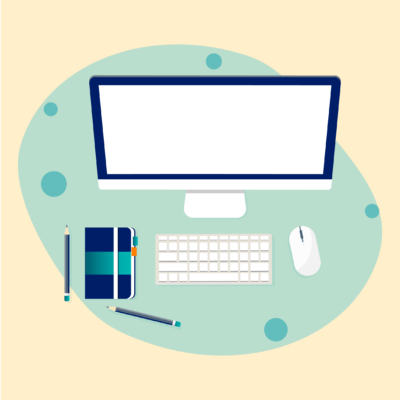
Are you someone who can relate to the phrase “cluttered space, cluttered mind?” It’s no secret that there are links between the space you live or work in affecting your mental health. I’m not going to say you need to make sure you keep your space organized and tidy—although that could be helpful. My suggestion is going to be to add more dopamine to your workspace.
There is a recent decorating trend called dopamine decor, have you heard of it? It’s a type of style that encourages bright colors, fun textures, patterns, funky furniture, etc. It also touches on ambient lighting and why overhead lights can be the worst. Fun colors and furniture may not be everyone’s aesthetic, but the main idea behind dopamine decor in general is just to surround yourself with things that make you feel happy or inspired. If it’s your cup of tea, throw up a “hang in there” cat poster. Add photos of loved ones, drawings from the kids, motivational quotes, music and movie posters, the list goes on. You can also add things like a coffee bar or a vinyl listening corner. Turn your workspace into somewhere that you’d actually like to be.
Another thing you could add to your workspace is, well, a person! Not every workplace is set up for this of course, but if you’ve got a trusted person in the office, ask them to work alongside you. Parallel play or body doubling is when it is easier to work on a task by just having someone near you. They don’t have to speak or be a part of the task, but having a body in the room can almost motivate or hold you accountable in a way. If you work virtually, this can also be accomplished over a video or audio call. Try it out!
Tip 7: Take "good" breaks.
As we already know, being a business owner with ADHD can have its benefits and challenges. Some days are bad focus days and it’s hard to get anything done, while other days you can be locked in. Whether you’re in boss mode that day or not, it’s important to utilize breaks to your advantage.
During my research I discovered a Psychology Today article about taking “good breaks” and avoiding “bad breaks.” “Good breaks” usually have a built-in stopping point or time constraint. That would be something like setting a 10-minute timer to walk away from your desk or taking that timed break after you complete a certain task. Having structured breaks make it easier to first remember to take the break—especially during a hyperfocus. Second, it reminds you to come back to the task, but of course that also requires the discipline to go back to the task when the timer is up.
“Bad breaks” are not constrained and could lead you down a slippery slope. It’s always amazing how the thought, “I’m just going to sit on my couch and scroll socials for a few minutes” turns into a 45-minute TikTok deep dive on the Titanic.
Another break method to consider is the Pomodoro Technique. The gist is that you define your goal or task to accomplish, set a timer for 25 minutes, then take a five-minute break. Rinse and repeat until the task is done.
Tip 8: Turn off your camera.
This might just be a me thing, but as a remote employee who connects with my team over video chat, I sometimes find it hard to focus if I’m being perceived. I end up being more hyper-fixated on making sure I don’t yawn or allow my face to say more than I want it to, rather than what anyone is saying. It can make things very challenging. While not every company, employer, or team may be keen on this, it could be something worth trying and asking for accommodation for in the future. I find it significantly easier to absorb what people are saying if listening to them is my only job at that moment. And frankly, it can also just be hard to stay still! I don’t think there is any science behind it, but I listen better when I can spin around in my chair at the same time.
If you work in person with customers or coworkers, consider a fidget toy. I find that playing with a fidget toy under my desk in meetings always helps with strengthening focus and lessening nervous energy. I know there are a lot of stigmas attached to fidget toys being childish or not being accepted in the workplace, but it doesn’t have to be that way. Fidget toys have really evolved and diversified in recent years. They don’t need to be colorful, loud, and flashy. An “appropriate” fidget toy in the workplace could be a Rubik’s cube, a paper clip, a marble, etc. It’s more about having something to do with your hands, the stimulation, than it is the fidget toy itself.
Tip 9: Work WITH your ADHD.

Are you someone who thrives with multi-tasking? Or someone who can’t possibly focus on multiple things at once? People with ADHD can really be anywhere in between. Sometimes it’s easier to just focus on one thing, but other times having yourself stimulated in other ways like auditory or sensory, for example, it can help increase focus. But it depends on you knowing yourself and figuring out what helps you be more productive—and what your workplace allows for.
I’m someone who doesn’t do well working in silence. It’s almost like my brain tries to fill the silent void with thoughts or distractions instead of the silence benefiting me and allowing me to focus more intently on my task. If you can relate to this, some things I have found are “mentally ranking” my task as well as the form of entertainment. Even in my personal life, I rank movies and TV shows into the category of “need to pay attention” or “can casually view”. Some forms of media require more focus to be appreciated properly, and I want to respect that, so I reserve that for a time when my brain will allow it. You can do the same thing for work!
Doing a monotonous data sheet could allow you to have fun listening to a podcast. This blog article was a big project for me, so I chose to listen to lo-fi music. There are actual links between lo-fi increasing focus in ADHD, and while that is true, I like it because it fills my head with pretty noise vs intruding thoughts. Other things that can be great to listen to are brown noise, classical music, a podcast, or instrumentals—a catch for this is that if you listen to the instrumental version of, say, “My Heart Will Go On” by Celine Dion, your brain could try to fill in the lyric gaps. Just something to pay attention to. On the flip side, if you need silence to be your most productive self, consider noise cancelling headphones.
If you already know what works best for you in regard to auditory stimulation, the next thing to consider is sensory. Maybe you could find you focus better standing, being in a spinny chair, using a walking pad, or a fidget toy like I mentioned above.
At the end of the day, multi-tasking can help or hurt you—it really just depends on you. If you know what works best for your ADHD and focus, do that! But if you’re still struggling, try mixing and matching some different auditory or sensory stimulations and see if it helps or hurts, explore with a little trial and error.
Tip 10: Don't force it.

The workplace for someone with ADHD can be a rigid and sometimes difficult to navigate landscape. While I can understand that not every job allows flexibility, I believe it’s important to advocate for yourself and ask for support and accommodation, if you see fit. (That’s one of the benefits of being a business owner with ADHD—you get to create an accommodating workplace for yourself!) Sometimes my worst days at work are when I have a mountain of urgent tasks, and I don’t even know where to start. Just knowing you have too much to do can get that executive dysfunction bubbling up. It can also feel overwhelming and lonely.
We’ve all been there, head in our hands, thinking: “why can’t I just do it?” Some days it is just not it. If you’re having one of those days and there are tasks and deadlines banging on your door, work with yourself and consider doing a smaller or familiar task first and see what happens. It could begin with that snowball effect I mentioned and inspire or motivate you to continue working. You could also try the Pomodoro Technique, starting with a shorter time—perhaps five or 10 minutes instead of 25.
I’m obviously not your boss—and you might be the boss if you’re reading this—but I’m just here to remind you to give yourself grace and patience when you need it. If you’re having a bad focus or productivity day, the most unhelpful thing you can do is beat yourself up over it. Learn to be okay with walking away if that’s what you need. Sometimes a brain refresh and a rested pair of eyes can bring more to the table than you ever thought possible during your first attempt.
If you are someone who has ADHD, you know that this list is just the tip of the iceberg. It is also usually easier said than done. Believe me, I can understand that. Being a business owner or just working in corporate America with ADHD can feel so overwhelming—like pushing a boulder up a hill some days. Or staring at a project for hours literally unable to begin it (kind of like me with this blog post, believe it or not). Just know you are not alone.
My own difficulties with ADHD in the workplace are what inspired this blog series, which we’re deciding to call the ADHD archives. This is the first installment, but there’s more to come soon. I could never pretend to fully know or understand how ADHD affects you personally, but I hope you are able to find some value in this list and future blog posts. Ta-ta for now!
Check back for more articles and resources in the ADHD archives on the Ruby blog.
